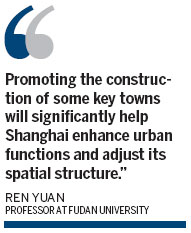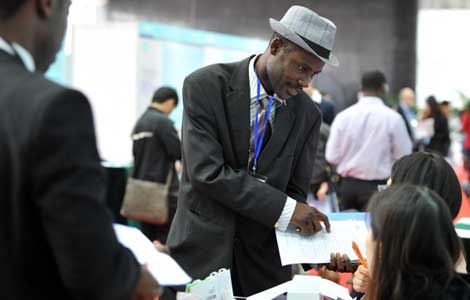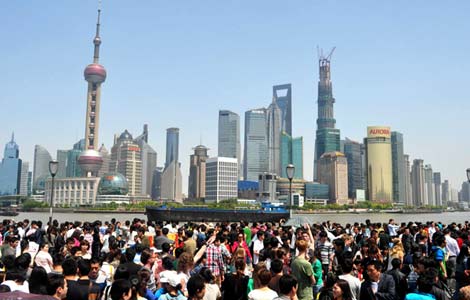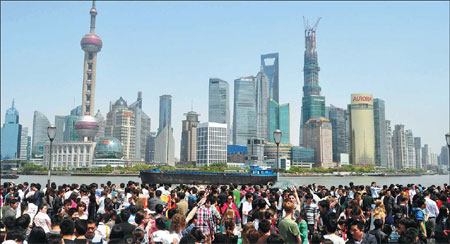Shanghai struggles with growth
Updated: 2013-07-11 08:06
By Zhou Wenting in Shanghai (China Daily)
|
||||||||
|
Tourists converge on the Bund in Shanghai on May 1, International Labor Day. Yan Daming / for China Daily |

Experts call for development of satellite towns to absorb new urban residents
Shanghai will face persistent population pressure in the coming years due to rapid urbanization in the city, with experts predicting the city's population will rise to around 30 million by 2030 - nearly the population of Canada at present.
To ease the situation, the city needs to further develop satellite towns and absorb more young migrant people to balance its aging population, experts said ahead of World Population Day, which falls on Thursday.
Shanghai's permanent resident population reached a record 23.8 million last year, according to the Shanghai Municipal Health and Family Planning Commission. This means that Shanghai boasts the largest population of any city in China, the most populous country in the world.
"By 2030, it's very possible the city will have 30 million people," said Zhou Haiwang, deputy director of the Institute of Population and Development under the Shanghai Academy of Social Sciences.
"Shanghai will face persistent population pressure due to rapid urbanization. The relatively high salaries in the city, compared with other parts of the country, also attract many migrants," he said.
Uneven distribution
According to experts, a major issue of concern is the uneven distribution of people across the city, with nearly 10 million people living in central areas. The population density in some central districts is more than 24,000 people per square kilometer, a figure far higher than other world-class cities, experts said. Meanwhile, the density on the outskirts of the city is very low, just one-sixth of that in central districts.
According to statistics from the Institute of Population and Development, there are around 2.7 million people in the downtown Huangpu district, which gives a population density of nearly 40,000 people per square kilometer, a figure that experts describe as a global rarity.
"I was sent overseas by my company for a year and I came back in February," said Tang Zhe, a resident of Huangpu district. "There are obviously more people and vehicles in the street than before. When I crossed the road at some big intersections, I felt I was completely overwhelmed in the crowd."
Ren Yuan, a professor from the School of Social Development and Public Policy at Fudan University, said that the suburbs should play a bigger role in the modernization of Shanghai.
"Promoting the construction of some key towns will significantly help Shanghai enhance urban functions and adjust its spatial structure," he said.
In 2011, Shanghai put forward the idea of building seven new towns in the suburbs, including Songjiang, Jiading, and Jinshan, but most of them have so far failed in their goal of absorbing 1 million residents each.
"People need to be employed when they move to the outskirts. The main industry in the suburbs is manufacturing, while people in downtown areas are good at service industries," said Yu Hongsheng, director of the Institute of Population and Development.
"The current level of public services and the structure of employment in suburbs are not competitive enough to make them satellite towns," he said.
Yu gave the example of Lingang, an area at the southeastern tip of Shanghai and a key location in a planned international shipping center, for which the municipality has drawn up blueprints. Since its construction in 2003, Lingang has become an important location for high-end manufacturing and strategic emerging industries, but the resident population is only 200,000.
"We often find it difficult to hail a taxi here. Not many taxi drivers are willing to come here because of the low population. It's like an empty city at nighttime," said Lin Guangyao, who settled in Lingang last year.
Although colleges have been moved there, the main faculty resources are still in urban areas, said Yu. Many industries face similar problems, as the core scientific research activities are still based in central districts.
The development of Songjiang district can be used as a model of how to proceed, according to Yu. There are colleges, hospitals, institutes of scientific research, multinational companies and service industries in the district.
"Shanghai needs to develop two or three areas with maturing infrastructure like Songjiang and keep making them good competitors of central districts," Yu said.
Solving the issues surrounding Shanghai's population explosion will take the combined efforts of the nation as a whole, say some experts, who believe the root causes lies in the development gap between regions.
"Instead of prosperity for a number of cities, ideal urbanization should involve cities in different areas taking advantage of their superiority in industrial structure and countering the imbalance in the regional economies," said Ren.
"That will help slow down the one-way flow of population migration and reduce the pressure on the megapolis," he said.
Balancing the population
Experts say it is important for Shanghai to continue absorbing young migrants, as they play an important role in correcting the imbalance in the ratio of old to young, while replenishing the labor force.
Residents younger than 17 make up only 10 percent of the total household population, according to the 2012 Shanghai Statistical Yearbook. The figure is far lower than the national average of 19 percent.
The yearbook also showed that one-fourth of the household population in Shanghai is over age 60.
"The number (of residents older than 60) is set to rise by around 200,000 annually between 2010 and 2020, and the rate of growth is likely to accelerate. The proportion of people aged over 80 will grow larger," Ren said.
However, only 200,000 people among the migrant residents are over 60, which means that 9.4 million migrant residents are of working age, between 16 and 59, he said. The local equivalent is 9.2 million, according to the 2012 yearbook.
"But migrant residents are facing a widening welfare gap between them and Shanghai natives, as well as inequality in employment opportunities, which is a growing challenge Shanghai has to deal with," Ren said.
Statistics from the Shanghai Municipal Statistics Bureau show the permanent migrant population reached 9.6 million in 2012, which accounted for more than 40 percent of permanent residents in the city.
And the city government has made efforts to ensure that Shanghai's labor welfare reforms keep pace with the speed of migrant labors entering the city, with the aim of tackling the problem of social differentiation, say experts, citing the point system for migrant residents, which took effect on July 1. The system translates migrants' personal circumstances and contributions into points on their residence permits, corresponding to the public services for which they are eligible. The points will be accumulated and a total of 120 can win the migrant resident major social benefits, such as social insurance and their children having the right to take the national college entrance exam in the city.
"The system sets out prospects for people moving to Shanghai, like me, and brings us favorable social benefits and means we are better integrated into the municipality," said Zheng Hua, a native of Changzhou, Jiangsu province, who works for a finance group in Shanghai.
zhouwenting@chinadaily.com.cn
(China Daily USA 07/11/2013 page5)

 China investigates GSK executives for bribery
China investigates GSK executives for bribery
 China, Russia complete 3-day joint naval drill
China, Russia complete 3-day joint naval drill
 US drone completes 1st carrier landing
US drone completes 1st carrier landing
 Sino-US talks 'help build trust'
Sino-US talks 'help build trust'
 Boston Marathon bombing suspect pleads not guilty
Boston Marathon bombing suspect pleads not guilty
 Caution urged in seeking experts from abroad
Caution urged in seeking experts from abroad
 Shanghai struggles with growth
Shanghai struggles with growth
 Trade town turns to tourism
Trade town turns to tourism
Most Viewed
Editor's Picks
|

|

|

|

|

|
Today's Top News
Smithfield CEO quells fears over Chinese purchase
Beijing has world's most delayed airport
Caution urged in seeking experts from abroad
Snowden is likely Venezuela bound
Talks 'help build trust' between China, US
Obama pushes House Republicans on immigration
Chinese researcher pleads guilty in US drug case
US Navy completes 1st unmanned carrier landing
US Weekly

|

|






